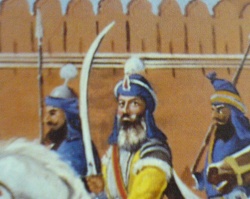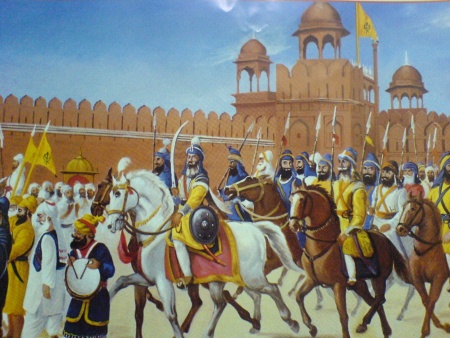Bhai Baghel Singh
Bhai Baghel Singh (d. 1802), who succeeded in 1765 Karora Singh as leader of the Karor singhia misl or chiefship, is celebrated in Sikh history as the vanquisher of Mughal Delhi. A Dhalival Jatt, Baghel Singh arose from the village of Jhabal, in Amritsar district, to become a formidable force in the cis Sutlej region. According to Syad Muhammad Latif, he had a force of 12,000 fighting men. As well as being a soldier, he was an adept in political negotiation and was able to win over many an adversary to his side. The Mughals, the Ruhilas, the Marathas and the English sought his friendship. In the wake of the decay of Mughal authority in the Punjab owing to Ahmad Shah Durrani's successive invasions during the latter half of the eighteenth century, the Sikhs began extending their influence. Baghel Singh took possession of portions of the Jalandhar Doab and established himself at Hariana, near Hoshiarpur. Soon after the Sikh conquest of Sirhind in January 1764, he extended his arms towards Karnal, occupying a number of villages including Chhalaudi which he later made his headquarters.
In February 1764, Sikhs in a body of 40,000 under the command of Baghel Singh and other leading warriors crossed the Yamuna and captured Saharanpur. They over ran the territory of Najib ud-Daulah, the Ruhila chief, realizing from him a tribute of eleven lakh of rupees. In April 1775, Baghel Singh with two other sardars, Rai Singh Bhangi and Tara Singh Ghaiba, crossed the Yamuna to occupy that country, then ruled by Zabita Khan, son and successor of Najib ud-Daulah. Zabita Khan in desperation offered Baghel Singh large sums of money and proposed an alliance jointly to plunder the crown lands.The combined forces of Sikhs and Ruhilas looted villages around the present site of New Delhi. In March 1776, they defeated the imperial forces near Muzaffarnagar. The whole of the Yamuna Gangetic Doab was now at their mercy.
When in the autumn of 1779, a large Mughal army under the command of Prince Farkhanda Bakht and Wazir Abdul Ahad Khan led an expedition against the cis Sutlej Sikhs, Baghel Singh along with Rai Singh of Buna and Bhanga Singh of Thanesar joined hands with the imperial forces at Karnal and encircled Patiala. Raja Amar Singh visited Baghel Singh in his camp at the village of Lahal and made peace with him and had his son. Sahib Singh, receive the rites of Khalsa initiation at his hands. Meanwhile, Amar Singh sought help from the Sutlej Sikhs. Baghel Singh out witted his imperial allies who sought safety in flight suffering heavy losses. In April of 1781, when Mirza Shafi, a close relative of the Mughal prime minister, captured the Sikh military post at Indri, 10 km south of Ladva, Baghel Singh retaliated by attacking Khalil Beg Khan of Shahabad who surrendered his force of 300 horse, 800 foot and 2 pieces of cannon. When on 11 March 1783, Sikhs entered the Red Fort in Delhi and occupied the Diwani-Am, the Mughal emperor, Shah Alam II, made a settlement with them agreeing to allow Baghel Singh to raise gurdwaras on Sikh historical sites in the city and realize six annas in a rupee (37.5%) of all the octroi duties in the capital. Baghel Singh stayed in Sabzi Mandi, with 4000 troops, and took charge of the police station in Chandni Chowk. He located seven sites connected with the lives of the Gurus and had shrines raised thereon within the space of eight months, from April to November 1783. Gurdwara Sis Gary marked the spot in the main Mughal street of Chandni Chowk where Guru Tegh Bahadur had been executed under the fiat of the emperor and Gurdwara Rikabganj, near modernday Parliament House, where the body was cremated. Bangla Sahib and Bala Sahib commemorated the Eighth Guru, Guru Har Krishan. Three other gurdwaras built were at Majnu ka Tilla, Moti Bagh and Telivara. Baghel Singh died probably in 1802, at Hariana, in present day Hoshiarpur district. A samadh enshrining the memory of one of the more picturesque misi sardars still stands in the town.
It is also commonly believed that Baba Baghel Singh with his army had camped in the jungles surrounding Delhi and were planning to secretly launch the attack. However there presence came to be known and the Mughal Emperor was informed that about 30 thousand sikhs were camping in the jungles. The place where the camp was established later came to be known as "Tis Hazari". This is where the present day Delhi High Court is loacated.
Another story goes that the Mughal Emperor when he came to know that Sikhs were planning to attack Delhi, as sufficient quantity of food and other essential commodities were stocked in the fort he ordered that all gates of the fort be closed so that the Sikhs camping in the jungles would soon run out of rations and go back. The Sikhs also realised that their surprise had been lost and it was impossible to capture the fort with all gates closed and locked. Some of the Sikhs accidently came across a mason from the neighbourly village who informed them that a particular place the wall of the fort had caved in from inside though the exterior was intact. He also agreed to lead the Sikh and show them this spot. The Sikhs planned to ram the wall with logs so as to make a hole in the wall and then enter the fort through his hole. This place is now called "Mori Gate" and this where the Inter State Bus Terminus (ISBT) in present Delhi is located.
References
1. Gian Singh, Giani, Panth Prakash [Reprint]. Patiala, 1970
2. Bhahgu, Ratan Singh, Prachin Panth Prakash [Reprint], Amritsar, 1962
3. Sital, Sohan Singh, Sikh Mislan. Ludhiana, 1952
4. Gupta, Hari Ram, History of the Sikhs, vol. III. Delhi, 1979
5. Harbans Singh, The Heritage of the Sikhs. Delhi, 1983


